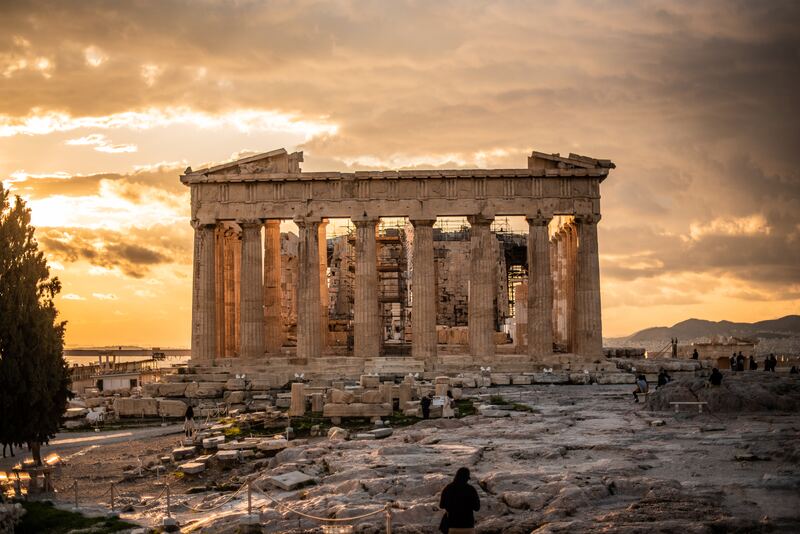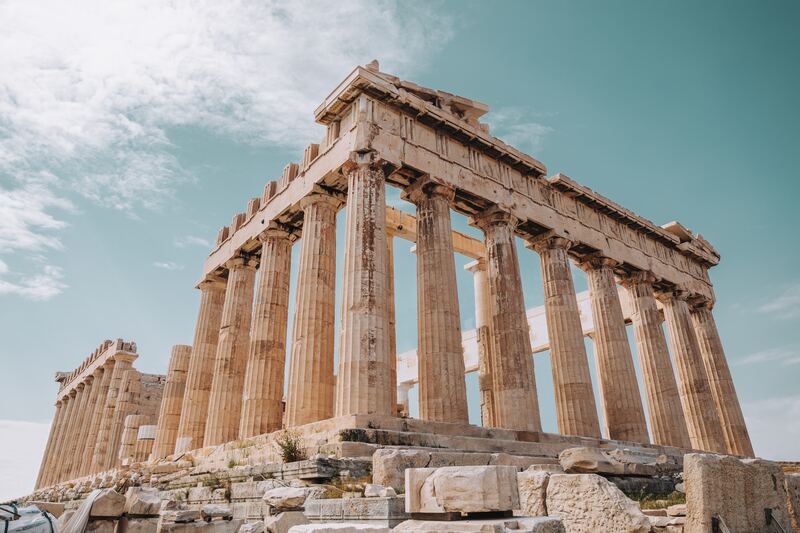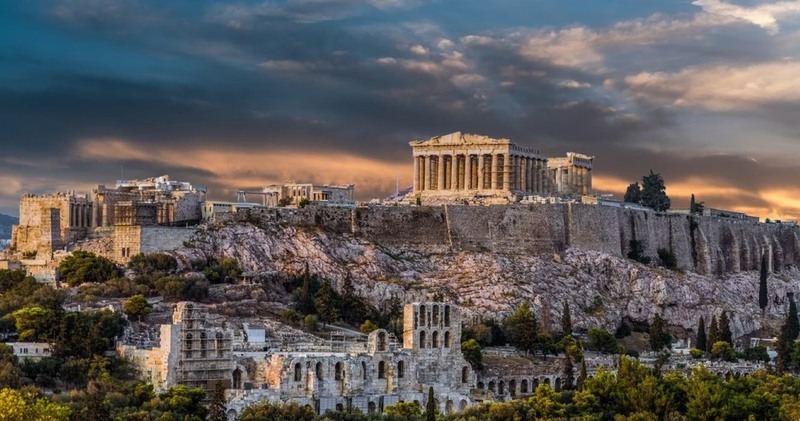If you want to explore the stunning beauty of the brilliant European civilization, the Parthenon is a destination you shouldn’t miss when traveling to Greece. This famous structure vividly embodies ancient European architecture with many beautiful aspects worth discovering.
When embarking on a journey to uncover the mesmerizing charm of Europe’s illustrious civilization, the Parthenon stands out as an unmissable landmark in Greece. This iconic monument encapsulates the essence of ancient European architectural brilliance, offering a plethora of captivating details for you to explore.
The Parthenon, perched majestically on the Acropolis of Athens, serves as a testament to the grandeur of ancient European artistry and engineering. Constructed in the 5th century BC, this temple was dedicated to the goddess Athena, the protector of Athens. Its Doric columns and intricate sculptures epitomize the sophistication of classical Greek design, reflecting a period when art and architecture were deeply intertwined with cultural and religious life.
Visiting the Parthenon allows you to step back in time and witness the ingenuity of ancient architects and sculptors. The precision of its construction, the harmony of its proportions, and the richness of its decorative elements are all marvels that continue to inspire awe and admiration. The Parthenon is not just a relic of the past but a symbol of the enduring legacy of European civilization, highlighting the achievements and aspirations of a society that has significantly shaped the world.
In addition to its architectural splendor, the Parthenon offers breathtaking views of Athens, blending the ancient with the modern in a unique panorama. As you stand amidst its ruins, you can reflect on the historical significance of this site, which has witnessed countless events and transformations over millennia.
In essence, the Parthenon is more than just an ancient structure; it is a gateway to understanding the rich tapestry of European history and culture. Its beauty and significance make it a must-visit destination for anyone eager to delve into the remarkable heritage of Europe.
- Parthenon Temple, famous architectural masterpiece in Greece
The Parthenon (or Pác Tê Nông Temple) is a renowned architectural marvel in Greece, constructed in the 5th century BC. Situated on the Acropolis, it stands as one of the surviving ancient structures of classical Greece.
The Parthenon was dedicated to the revered goddess Athena. This temple is celebrated as a magnificent achievement of ancient Greek architecture. Despite the passage of time, the architectural traces left behind continue to amaze travelers.
This splendid structure symbolizes the end of ancient Greece and the Athenian democracy. Despite undergoing significant changes in function and exterior design, the temple remains one of the world’s greatest cultural monuments.
The Parthenon, perched prominently on the Acropolis of Athens, was built to honor Athena, the city’s patron goddess. Its construction marked the height of Athenian power and artistic achievement. The temple’s Doric columns, sculpted friezes, and meticulous proportions exemplify the pinnacle of ancient Greek architectural prowess. As you walk through its ruins, the grandeur of its design and the meticulous craftsmanship are still evident, evoking a sense of awe and admiration.
Throughout history, the Parthenon has witnessed numerous transformations. Initially serving as a temple, it later became a church, a mosque, and even a gunpowder storage facility. Despite these changes, the essence of its original grandeur persists. Its survival through centuries of conflict and change is a testament to the resilience of human creativity and cultural heritage.
The Parthenon is not merely an ancient relic; it is a profound symbol of the legacy of Greek civilization. Its influence extends beyond architecture, inspiring countless works of art, literature, and philosophy. Visiting the Parthenon offers a glimpse into the world of ancient Greece, allowing you to connect with a pivotal era in human history.
Moreover, the Parthenon provides a stunning view of modern Athens, linking the ancient past with the present. Standing among its columns, you can reflect on the achievements of a civilization that laid the foundations for many aspects of contemporary society.
In summary, the Parthenon is a monumental testament to the ingenuity and artistic brilliance of ancient Greece. Its enduring beauty and historical significance make it an essential destination for anyone interested in exploring the roots of Western civilization.

- Visiting time and admission price of the Parthenon Temple
Currently, the Parthenon is open for visitors from 8 AM to 8 PM daily. However, from November 1st to March 31st, the visiting hours are adjusted to 8 AM to 5 PM.
The Parthenon is closed on specific dates: January 1st, March 25th, May 1st, December 25th, December 26th, and Easter Sunday. It’s advisable to plan your visit accordingly to avoid these dates.
The entrance fees for the Parthenon are as follows:
- Adult ticket: 20 euros
- Child ticket: 10 euros
Nevertheless, consider visiting the Parthenon on the first Sunday of each month, as admission is free on this day. Additionally, free entry is offered on March 6th, April 18th, May 18th, the last weekend of September, and October 18th.
For those planning a trip to the Parthenon, it is essential to be aware of the operational hours and specific closure dates to make the most of your visit. The varying admission hours between the summer and winter seasons reflect the site’s adaptation to different daylight conditions and tourist flow.
The Parthenon, a symbol of ancient Greek architectural excellence, remains a significant cultural attraction that draws numerous visitors. Ensuring you visit during the open hours and avoiding the specified closed dates will enhance your experience, allowing ample time to appreciate the historical and architectural marvels.
The ticket pricing structure is straightforward, with reduced rates for children, making it a family-friendly destination. However, the availability of free entry on certain days provides an excellent opportunity for budget-conscious travelers to explore this iconic site without any cost.
The monthly free admission on the first Sunday is particularly beneficial, promoting wider access to this UNESCO World Heritage site. The additional free entry dates, tied to significant cultural and historical observances, encourage more people to connect with Greece’s rich heritage.
In summary, understanding the Parthenon’s operational schedule, ticket pricing, and free entry opportunities will help you plan an enriching visit to this ancient wonder, ensuring you can fully immerse yourself in its historical grandeur.

- Instructions for traveling to the Parthenon Temple
You can travel to the Parthenon from Vietnam by air. Airlines such as Vietnam Airlines, Qatar Airways, and Etihad Airways offer direct flights from Ho Chi Minh City and Hanoi to Greece. Ticket prices tend to be higher in July, August, and during Easter. Planning ahead to book your tickets and complete the necessary travel arrangements will ensure a smooth and enjoyable trip.
Flying from Vietnam to Greece involves several options for travelers. Vietnam Airlines provides reliable service with a reputation for good customer care. Qatar Airways and Etihad Airways, known for their extensive international networks, also offer convenient routes to Greece. These airlines often provide comfortable flights with various amenities, making the long journey more pleasant.
Booking your flight in advance is crucial, especially if you plan to travel during peak seasons such as summer or Easter. These periods see a surge in tourist activity, leading to increased demand and higher ticket prices. By securing your tickets early, you can benefit from better prices and a wider selection of flight times, enhancing the overall travel experience.
Once in Greece, the journey to the Parthenon is straightforward. Located in Athens, the Parthenon is easily accessible from the city’s main airport, Eleftherios Venizelos. You can choose from various transportation options, including taxis, buses, and the metro, to reach the Acropolis, where the Parthenon stands majestically.
Visiting the Parthenon is a step into history, allowing you to experience the grandeur of ancient Greek civilization. The temple, with its enduring beauty and historical significance, offers a profound connection to the past. Ensuring that all travel arrangements are in place will help you focus on soaking in the cultural and architectural wonders that await you.
In summary, flying from Vietnam to Greece with airlines such as Vietnam Airlines, Qatar Airways, or Etihad Airways, and planning your trip well in advance, especially for peak travel periods, will make your visit to the Parthenon seamless and memorable. This careful preparation will allow you to fully enjoy and appreciate one of the most iconic landmarks in the world.
- The right time to visit the Parthenon Temple
According to information gathered by Gomsubaoloc, Athens enjoys a mild and pleasant climate year-round. Therefore, you can visit the Parthenon at any time of the year to explore and enjoy the fresh atmosphere without worrying about weather disruptions.
However, the ideal time to visit is from April to October. From November to March, Athens experiences winter, which can be quite harsh and often rainy.
Additionally, you should consider whether to visit the Parthenon in July and August. These months are the peak tourist season in Athens, making attractions crowded and prices higher.
The Parthenon tends to get crowded around 10 AM when cruise ships dock. To enjoy a more tranquil and peaceful atmosphere, it is best to avoid visiting during this time.
Athens’ climate, characterized by its year-round mildness, makes it an inviting destination for travelers at any time. The Parthenon, a historic marvel, is accessible throughout the year, offering an uninterrupted experience of its grandeur regardless of the season.
From April to October, the weather in Athens is especially favorable, providing a comfortable environment for sightseeing. The sunny and warm conditions during these months enhance the enjoyment of outdoor activities and exploration of ancient sites. On the other hand, the winter months from November to March bring colder temperatures and frequent rain, which might limit outdoor excursions.
When planning your visit, it is crucial to be mindful of the peak tourist season in July and August. During these months, Athens sees a significant influx of tourists, leading to crowded attractions and higher prices for accommodations and services. If you prefer a more relaxed and less crowded experience, visiting outside these peak months is advisable.
To maximize your experience at the Parthenon, consider the timing of your visit within the day. The site tends to become particularly crowded around 10 AM due to the arrival of cruise ship passengers. Visiting either early in the morning or later in the afternoon can provide a more serene and enjoyable experience, allowing you to appreciate the site’s historical and architectural beauty without the hustle and bustle of large crowds.
In conclusion, while Athens’ climate allows for year-round visits, planning your trip between April and October will likely offer the best weather conditions. Being aware of peak tourist seasons and timing your visit to avoid the busiest hours will help ensure a more pleasant and fulfilling exploration of the Parthenon and its surroundings.
